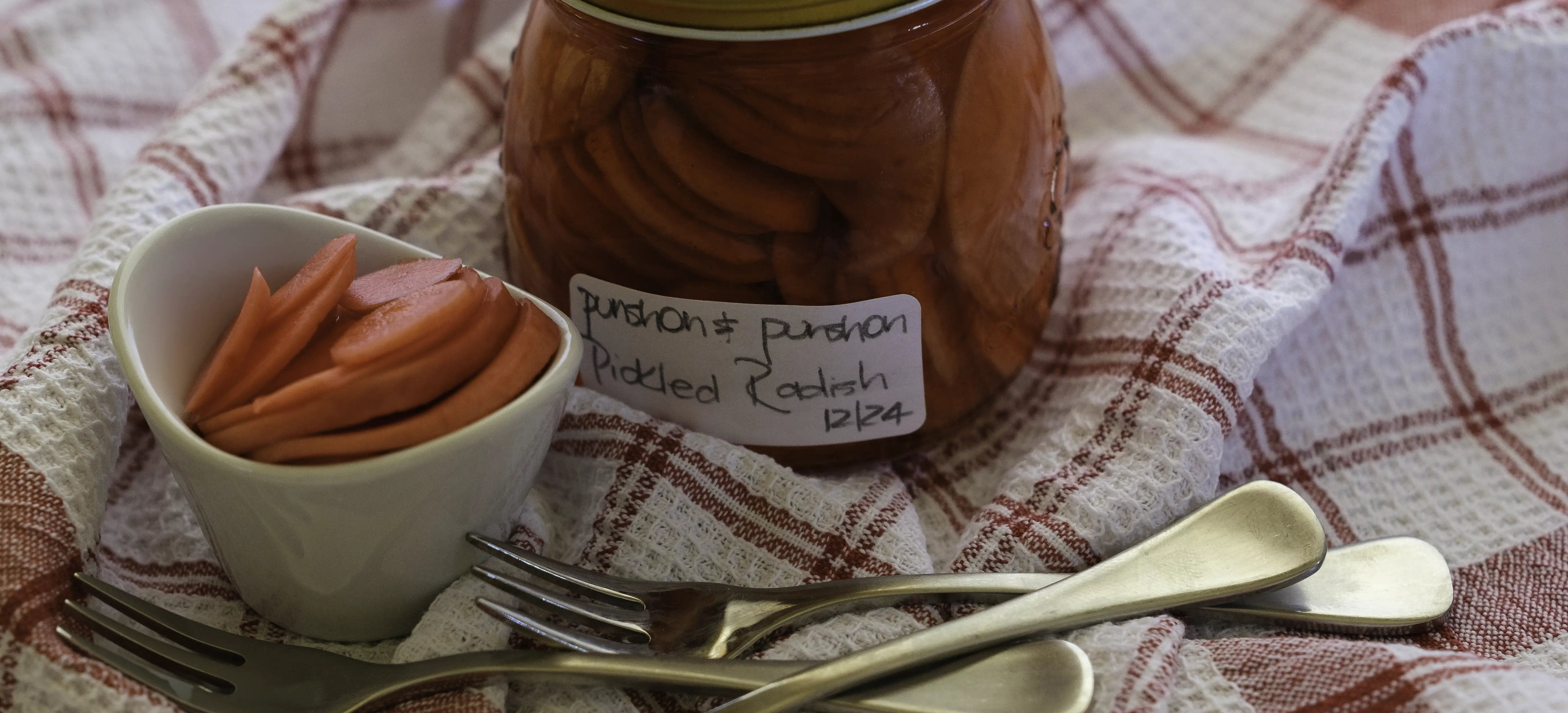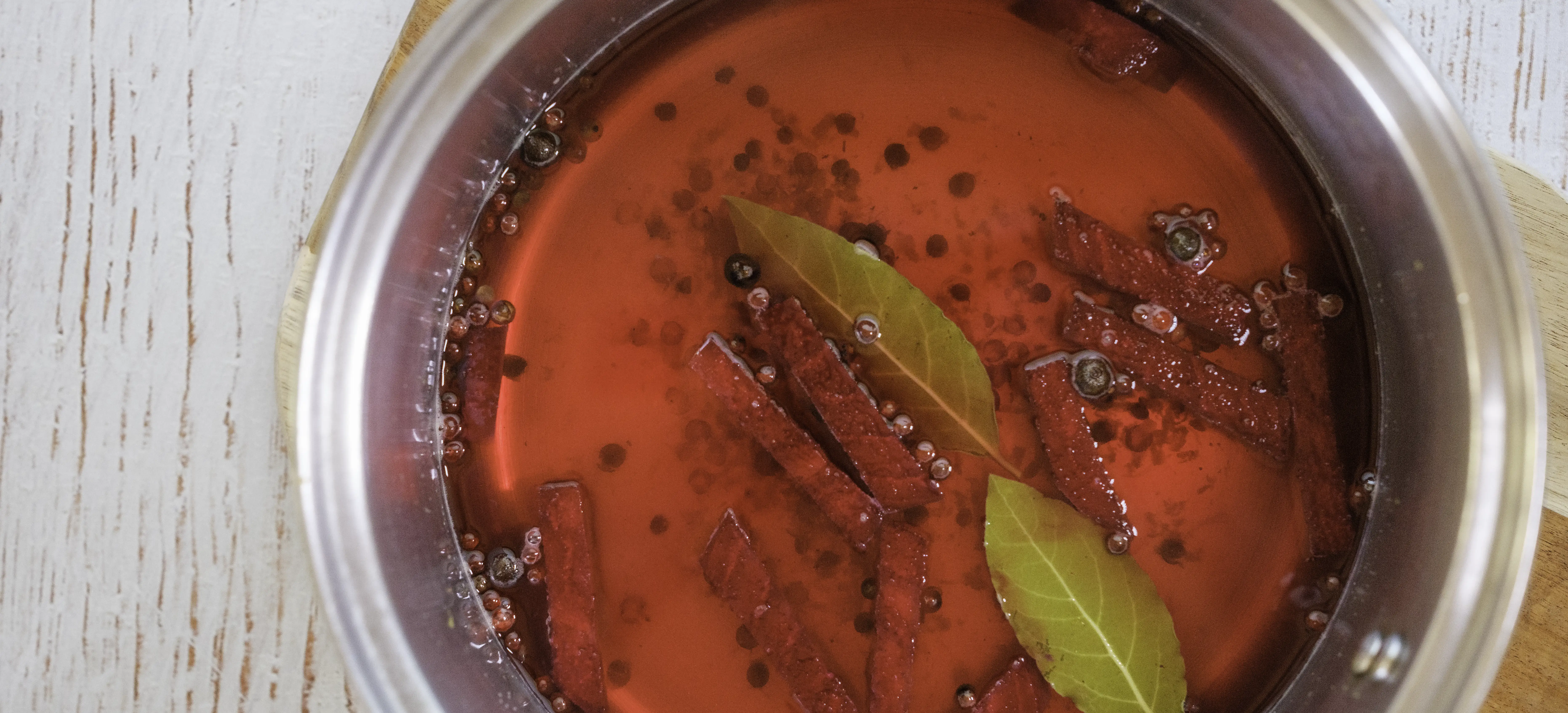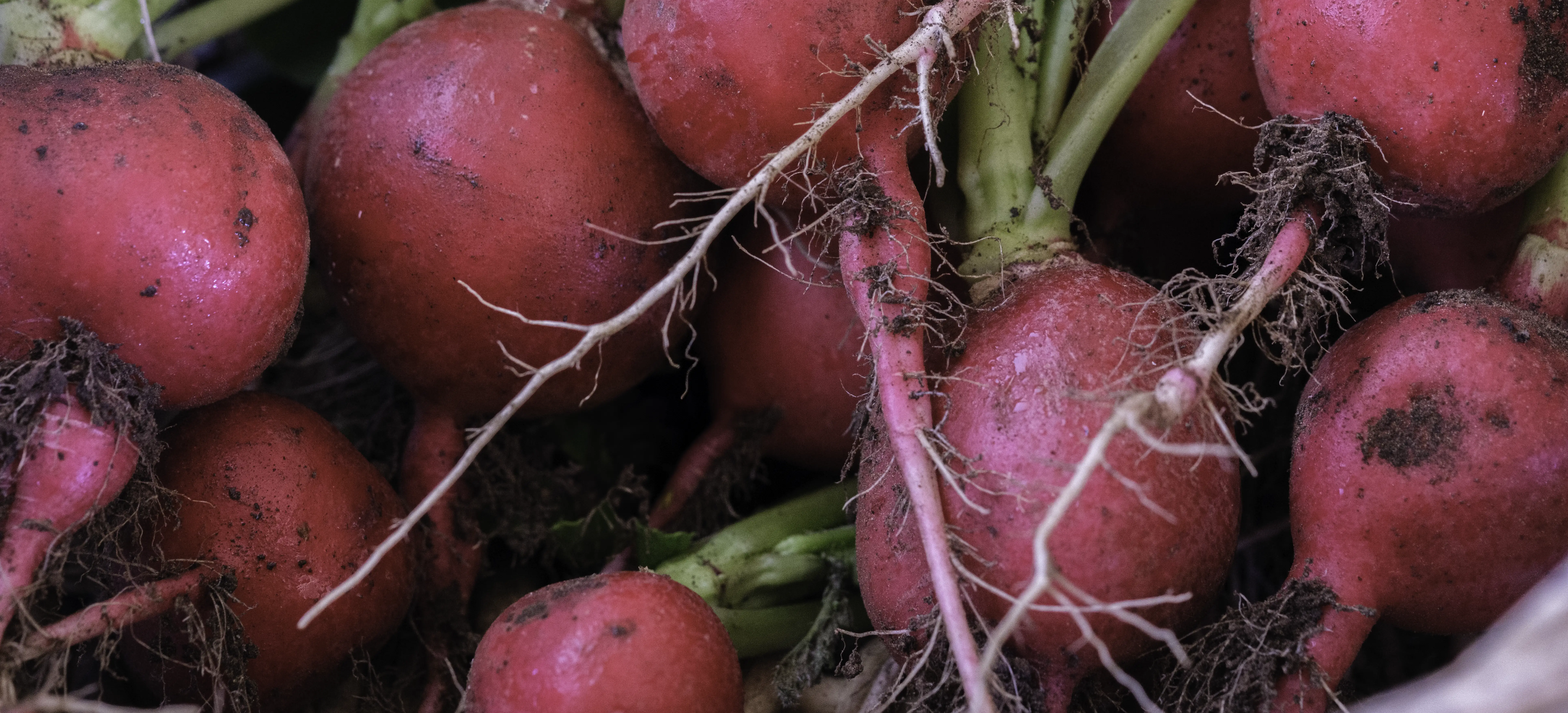Pinky Pickled Radish
- Pickles, Chutney, Relish & Sauces

A refreshing pickle with the renowned spicy bite of radish – what a great combination. It’s pink, it’s pretty and it’s pretty darn good. Use with a mezze of dips, cold meats and other pickles, to accompany cold seafood dishes, or simply as a meal starter. No doubt you will discover other perfect pairings. Over the festive season, this is a staple in our kitchen. Radishes are available from midsummer to late autumn.
- Preparation Time:
- 20 minutes
- Cooking Time:
- 20 minutes
- Quantity:
- 4 x 170ml jars
PREPARATION
Sterilise glass jars and lids with a protective lining. Have the jars and lids dry, room temperature and ready for the bottling stage.

INGREDIENTS
- 500 ml
- Apple cider vinegar
- 165g
- White sugar
- 4
- Beetroot, peeled slices
- 2
- Bay leaves
- 6
- Allspice berries
- 2 teaspoons
- Pink peppercorns
- 1 teaspoon
- Sea salt
- 1 kg
- Red radish, fresh, crisp
METHOD
Use the Sealing in a Cold Jar method, after the jars and lids have been sterilised. More information provided in the Notes Section below.
Combine sugar, salt and vinegar into a preserving pan or heavy-bottom stainless-steel pan. Heat gently to dissolve the sugar.
Add the bay leaves, allspice berries, pink peppercorns and beetroot. Simmer gently for approximately 10 minutes to extract the flavours and beetroot colour.
Remove from the heat and allow the mixture to cool. Strain, remove the bay leaves, allspice berries and beetroot and discard. Retain the pink peppercorns if you want to add a contrasting element to the jarred pickle.
Wash and gently dry the radishes to remove any shop or garden dust and debris. Dry the radishes on a clean tea towel or paper towel to remove any excess moisture.
Top and tail the radish and slice evenly into 2 mm disks. Transfer the radish slices to the sterilised jars, stacking them carefully to maximise the number of slices in each jar. Do not over fill the jars at this point.
Using a funnel or ladle, cover the radish with the spice vinegar solution and fill to approximately 2.5 cm (1 inch) from the top of the jar. The vinegar must completely cover the fruit. Add a few pink peppercorns for effect. Seal immediately and wipe the jars down to remove any spills during the bottling stage.
Label and store in a cool dark place in the kitchen or pantry.
Allow the pickles to mature for at least 2 days before eating.
After opening store in the refrigerator.
NOTES

- Choose fresh crisp radishes. Do not use wrinkly, dehydrated and/or wilted radishes. This will produce a poor-quality preserve.
- Good quality jars should be used in all preserving, particularly when they are processed in a hot water bath. Thin jars often cannot withstand the temperatures and may crack either in the bath or on and or after removal. Avoid the disappointment and invest in some good jars from a homewares or preserves outlet. Select jars that have non-reactive lids as the vinegar solution can cause the lids to rust over time.
- Types of Sugar & Vinegar
- The type and colour of the sugar and vinegar used will affect the final colour and flavour of preserves. Malt vinegar and brown sugar will produce a very dark brownish red preserve with a more earthy/molasses background flavour, while white wine or apple cider and white sugar will produce a fresher and brighter flavour.
- The type of vinegar and sugar can be substituted in any recipe if you are seeking a different style.
- This recipe uses apple cider vinegar and white sugar to retain the vibrant pink colour from the beetroot and to retain a bright, fresh summery pickle.
- Take care to only use vinegar which has a 5% minimum acetic acid content. The acetic acid content acts as the principal preservative, and any lower quantity will compromise the safety of your preserves. Most commercially available vinegar is 5%, however most homemade vinegars do not achieve this level. This info is usually on the back label or on the product’s website.
- Sealing In a Cold Jar
- This recipe is a “fresh style’ pickle. The radish is not fermented or cooked and they are covered with cold spiced vinegar. To produce a quality safe preserve, it’s important that the jar, lid and ingredients are the same temperature.
- Sterilise the jars and lids, cover with a clean dry tea towel and allow to cool to room temperature before use.
- This method will not create a vacuum seal like the Hot Jar, Hot Ingredient and Hot Lid method does, hence its shelf life is not as long. Use the pickle within 6 months and once opened store in the fridge.
- Which Salt?
- There are many different types of salts on the market, and each has different characteristics.
- Use good quality pickling salt when making pickles and preserves. Many commercial salt brands contain stabilisers and anti-caking agents and often iodide which forms a whitish haze and sediment. These additives and in particular iodine can affect the appearance and taste of pickles and preserves during the maturation and storage period. The ingestion of a cocktail of anti-caking chemicals such as calcium silicate, sodium silicoaluminate, tricalcium phosphate, magnesium carbonate, silicon dioxide and yellow prussate of soda, is also unnecessary. Read the label before buying and look for salt that is free from any artificial additives. My favourite salt is Olsson Cooking Salt. No commercial benefit is received from Olsson Salt.
- Lite Salt may be used in quick pickle recipes; however, it may result in a slightly different taste than expected.
- The natural calcium and magnesium impurities of unrefined sea salt helps to cross link and reinforce the cell wall pectin’s, creating a crisp pickle.
- Substitutions
- If you are unable to obtain pink peppercorns, use white peppercorn.
- Do not substitute ground allspice for the allspice berries. The powder will remain suspended in the vinegar solution and change the colour to a murky brown .
- Knowing your Spices
- Allspice (Pimenta diocia)
- Allspice comes from an evergreen tree in the myrtle family. Twigs bearing the berries are picked in summer when the berries are mature but still green. Berries are sweated in containers to release their active ingredients then dried.
- Whole berries retain their flavour well and will keep almost indefinitely sealed in a cool dark place.
- They contain a rough surface which contains tiny oil glands and most of the flavour is contained in the wrinkled husk, not the seeds. Allspice powder quickly loses potency.
- Best to buy in small quantities and keep sealed in cool dark place for up to 6 months. It’s also known as Jamaican pepper, clove pepper, pimento and suits both sweet and savoury dishes.
- Bay Leaves (Laurel nobilis)
- Leaves are harvested any time of the year from a hardy evergreen tree that grows up to 7 meters. It’s native to the Eastern Mediterranean/Asia Minor Region.
- Today it is cultivated mainly in Türkiye which supplies 90% of the world market.
- It is also known as sweet bay and bay laurel. Fresh leaves have a pungent and lingering astringency with a fresh camphor scent. Dried bay leaves have a more distinctive aroma but is not as bitter.
- Peppercorns – Pink (Schinus terebinthifolius)
- Two different types of peppercorns are available and they come from different plants. The true pink ripe peppercorn comes from the black peppercorn vine which produces what we know as black pepper (Piper nigrum) whereas the pink peppercorn berries generally used for culinary purposes come from the Schinus terebinthifolius tree.
- It has a pine-like flavour, is milder and has a fresher fruitier taste than black pepper and has a more delicate structure making it easier to crack or crush.
- Allspice (Pimenta diocia)
